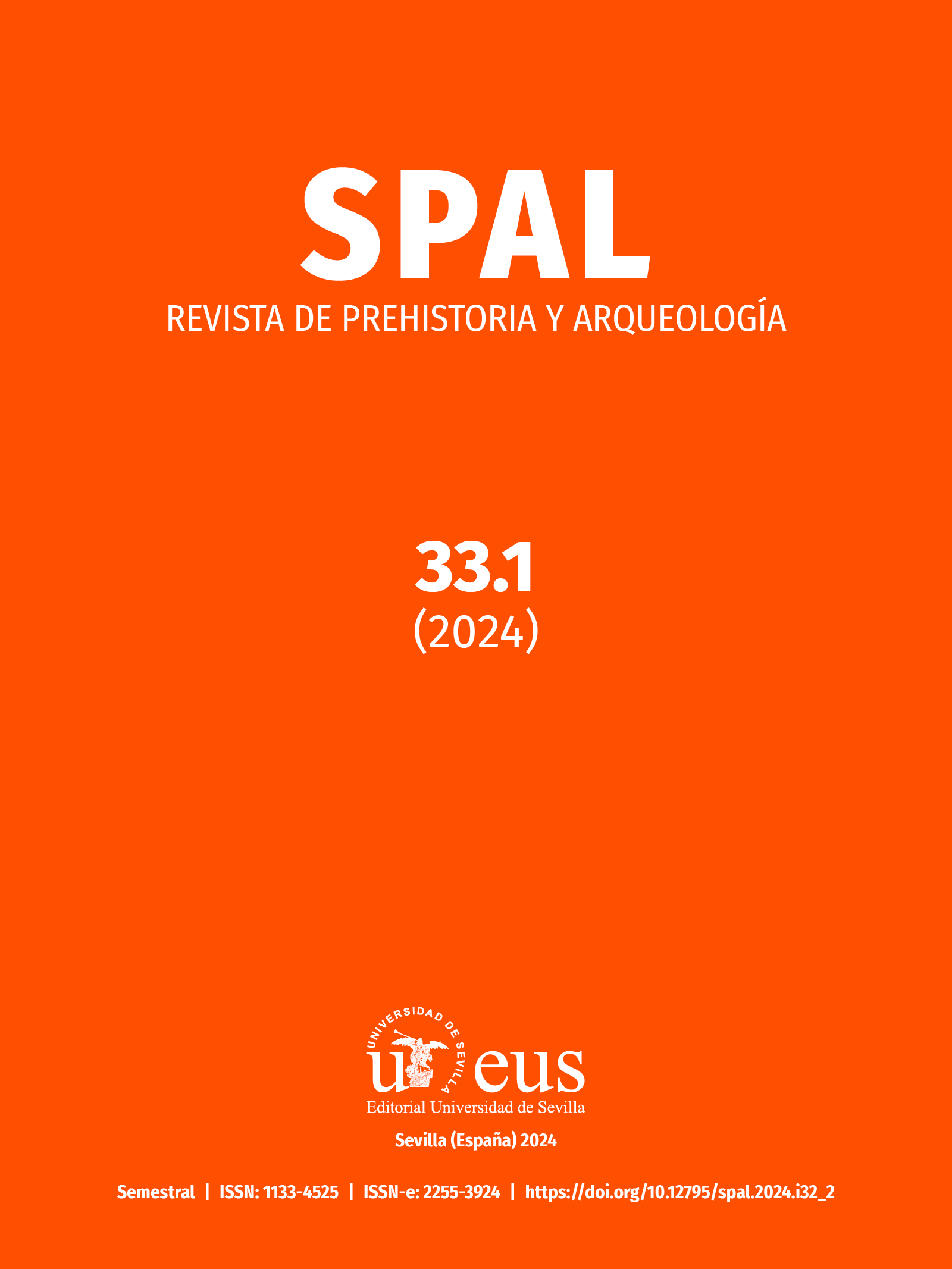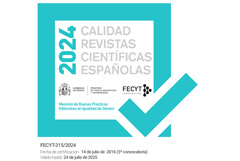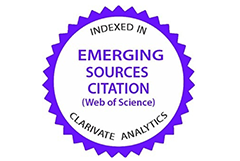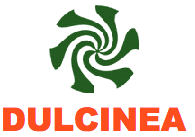Los recintos de fosos calcolíticos de la península ibérica, ¿fueron fortalezas? Análisis de Xancra y El Casetón de la Era desde una perspectiva poliorcética
DOI:
https://doi.org/10.12795/spal.2024.i33.02Palabras clave:
Arqueología, Prehistoria, poliorcética, fortificación, recintos de fososResumen
A menudo, los llamados recintos de fosos neolíticos y calcolíticos de la península ibérica (IV-III milenios a. C.) han sido interpretados como fortificaciones. Sin embargo, escasean los estudios específicos sobre el particular. En este trabajo, se intenta contribuir al debate a través de analogías con fortificaciones históricas y prehistóricas bien conocidas. Se efectúa el análisis detallado, desde una perspectiva poliorcética, de dos recintos fosados calcolíticos: Xancra (Cuba, Beja, Portugal) y El Casetón de la Era (Villalba de los Alcores, Valladolid, España). Los resultados del estudio sugieren que las líneas concéntricas de fosos que conforman dichos sitios muestran ciertas optimizaciones orientadas a la defensa. No obstante, al mismo tiempo, como fortificaciones ambos exhiben numerosas características no canónicas. En la discusión se plantean dos posibles explicaciones. Según la primera, la ineficiencia de su diseño se debe a la ignorancia por parte de sus constructores de algunos de los principios más elementales de la poliorcética. Según la segunda, la elección de su lugar de emplazamiento, así como su diseño arquitectónico, se llevaron a cabo con otros propósitos además del puramente militar, o por encima de este.
Descargas
Citas
Adam, J. P. (1982) L’architecture militaire grecque. Paris: Picard.
Alcock, L. (1973) Arthur’s Britain: history and archaeology AD 367-634. Harmondsworth: Penguin Books.
Anglim, S. (ed.) (2002) Fighting techniques of the ancient world: 3000 BC-500 AD: equipment, combat skills, and tactics. New York: Thomas Dunne Books-St. Martin’s Press.
Arnold, B. y Fernández-Götz, M. (2018) “Agency in architectural choice: the Heuneburg hillfort as monument and metaphor”, en Ballmer, A., Fernández-Götz, M. y Mielke, D. P. (eds.) Understanding ancient fortifications: between regionality and connectivity. Havertown, Pennsylvania: Oxbow Books, pp. 148–155.
Baker, J. T. y Brookes, S. (2013) Beyond the Burghal Hidage: Anglo-Saxon civil defence in the Viking Age. Leiden: Brill.
Becker, H., Valera, A. C. y Castanheira, P. (2012) “Monte do Olival 1 (Ferreira do Alentejo, Beja): Magnetometria de césio num recinto de fossos do 3º milénio aC“, Apontamentos de Arqueologia e Património, 8, pp. 11–17.
Biermann, F. (2016) “North-Western Slavic strongholds of the 8th–10th centuries AD”, en Christie, N. y Herold, H. (eds.) Fortified settlements in early medieval Europe: defended communities of the 8th-10th centuries. Oxford, Philadelphia: Oxbow Books, pp. 85–94.
Binford, L. R. (1981) Bones: ancient men and modern myths. New York: Academic Press.
Black, J. (2018) Fortifications and siegecraft: defense and attack through the ages. Lanham, MD: Rowman & Littlefield.
Bowden, W. (2016) “A window on an uncertain world: Butrint and the fortified sites of Epirus in the 7th–9th centuries AD”, en Christie, N. y Herold, H. (eds.) Fortified settlements in early medieval Europe: defended communities of the 8th-10th centuries. Oxford, Philadelphia: Oxbow Books, pp. 235–247.
Calado, M. (2000) “Neolitização e megalitismo no Alentejo Central: uma leitura espacial”, en Jorge, V. O. (ed.) Neolitização e megalitismo da Península Ibérica. Actas do 3º Congresso de Arqueologia Peninsular, vol. 3. Vila Real 1999. Porto: ADECAP, pp. 35–45.
Cámara Serrano, J. A. y Molina González, F. (2013) “Indicadores de conflicto bélico en la Prehistoria reciente del cuadrante sudeste de la Península Ibérica: el caso del Calcolítico”, Cuadernos de Prehistoria y Arqueología de la Universidad de Granada, 23, pp. 99–132. https://doi.org/10.30827/cpag.v23i0.3104
Cámara Serrano, J. A., Spanedda, L., Gómez del Toro, E. y Lizcano Prestel, R. (2011) “La discusión sobre la función de los fosos en la Prehistoria Reciente del sur de la Península Ibérica. Modas y temores”, en Abellán Pérez, J., Lazarich González, C. y Castañeda Fernández, V. (eds.) Homenaje al Profesor Antonio Caro Bellido. Cádiz: Universidad de Cádiz, pp. 61–80.
Campbell, D. B. (2008) Roman legionary fortresses 27 BC-AD 378, Fortress, 43. Oxford: Osprey.
Christie, N. (2016) From Constantine to Charlemagne: an archaeology of Italy, AD 300-800. Abingdon, Oxon: Routledge.
Christie, N., Creighton, O., Edgeworth, M. y Hamerow, H. (2013) Transforming townscapes: from ‘burh’ to borough the archaeology of Wallingford, AD 800-1400, The Society for Medieval Archaeology Monograph, 35. London: Routledge. https://doi.org/10.4324/9781351191432
Comber, M. (2016) “The Irish cashel: enclosed settlement, fortified settlement or settled fortification? With evidence from ongoing excavations at Caherconnell, Co. Clare, Western Ireland”, en Christie, N. y Herold, H. (eds.) Fortified settlements in early medieval Europe: defended communities of the 8th-10th centuries. Oxford-Philadelphia: Oxbow Books, pp. 3–13.
Corfis, I. A. y Wolfe, M. (eds.) (1999) The medieval city under siege. Woodbridge, Suffolk: Boydell.
Crespo Díez, M., Rodríguez Marcos, J. A., Delibes de Castro, G. y Becker, H. (2015) “Prospección magnética en el recinto de fosos calcolítico de “El Casetón de la era” (Villalba de los Alcores, Valladolid): representación gráfica e interpretación arqueológica”, BSAA Arqueología, 81, pp. 55–84.
Cruz-Auñón Briones, R. y Arteaga Matute, O. (1999) “Acerca de un campo de silos y un foso de cierre prehistóricos ubicados en “La Estacada Larga” (Valencina de la Concepción, Sevilla). Excavación de urgencia de 1995”, en Anuario Arqueológico de Andalucía, 1995 (3). Sevilla: Consejería de Cultura, Junta de Andalucía pp. 600–607.
D’Amato, R. (2016) “Siegeworks and fortifications”, en Irby-Massie, G. L. (ed.) A companion to science, technology, and medicine in ancient Greece and Rome, Blackwell Companions to the Ancient World. Chichester-Malden, MA: Wiley Blackwell, pp. 784–200.
De Staebler, P. D. (2016) “Aphrodisias”, en Müth, S., Schneider, P. I., Schnelle, M. y De Staebler. P. D. (eds.) Ancient fortifications: a compendium of theory and practice, Fokus Fortifikation Studies, 1. Philadelphia: Oxbow Books, pp. 267–272.
Delibes de Castro, G., Crespo Díez, M., Fernández-Manzano, J., Herrán Martínez, José Ignacio, J. I. y Rodríguez Marcos, J. A. (2009) “Un recinto de fosos calcolítico en el valle medio del Duero: El Casetón de la Era (Villalba de los Alcores, Valladolid)”, en Actas de las IV Jornadas Científicas de Patrimonio Arqueológico en la Comunidad de Madrid. Madrid 2007. Madrid: Comunidad de Madrid, pp. 239–247.
Delibes de Castro, G., García García, M., del Olmo, J. y Santiago, J. (2014) Recintos de fosos calcolíticos del Valle Medio del Duero. Arqueología aérea y espacial, Studia Archaeologica, 100. Valladolid: Universidad de Valladolid.
Delibes de Castro, G., Crespo Díez, M. y Rodríguez Marcos, J.A. (2016) “Anatomía de un recinto de fosos calcolítico del valle medio del Duero: el Casetón de la Era (Villalba de los Alcores, Valladolid)”, en Del neolític a l’edat de bronze en el Mediterrani occidental: Estudis en homenatge a Bernat Martí Oliver, Trabajos Varios del Servicio de Investigación Prehistórica del Museo de Prehistoria de Valencia, 119. Valencia: Museu de Prehistòria de València, pp. 387–402.
Díaz-del-Río, P. (2003) “Recintos de fosos del III milenio AC en la Meseta peninsular”, Trabajos de Prehistoria, 60 (2), pp. 61–78. https://doi.org/10.3989/tp.2003.v60.i2.81
Ettel, P. (2013) “Frankish and Slavic fortifications in Germany from the seventh to the eleventh centuries”, en Baker, J. T., Brookes, S. y Reynolds, A. J. (eds.) Landscapes of defence in Early Medieval Europe, Studies in the Early Middle Ages, 28. Turnhout: Brepols, pp. 261–284.
Faulkner, P. A. (2016) “Castle planning in the Fourteenth Century”, en Liddiard, R. (ed.) Late Medieval castles. Woodbridge: The Boydell Press, pp. 79–100.
Fields, N. (2004a) Mycenaean citadels c. 1350-1200 BC. Oxford: Osprey.
Fields, N. (2004b) Troy c. 1700-1250 BC. Oxford: Osprey.
Fields, N. (2006) Ancient Greek fortifications, 500-300 BC, Fortress, 40. Oxford-New York: Osprey Pub.
García García, M. (2017) La edad de los metales en el Duero medio: la evolución del paisaje y de las sociedades, Studia Archaeologica, 102. Valladolid: Universidad de Valladolid.
García Sanjuán, L., Scarre, C. y Wheatley, D. W. (2017) “The mega-site of Valencina de la Concepción (Seville, Spain): debating settlement form, monumentality and aggregation in Southern Iberian Copper Age societies”, Journal of World Prehistory, 30 (3), pp. 239–257. https://doi.org/10.1007/s10963-017-9107-6
Gibaja, J. F., Crespo Díez, M., Delibes de Castro, G., Fernández Manzano, J., Fraile, C., Herrán, J. I., Palomo, A. y Rodríguez Marcos, J. A. (2012) “El uso de trillos durante la Edad del Cobre en la Meseta española. Análisis traceológico de una colección de denticulados de sílex procedentes del “recinto de fosos” de El Casetón de la Era (Villalba de los Alcores, Valladolid)”, Trabajos de Prehistoria, 69 (1), pp. 133–148. https://doi.org/10.3989/tp.2012.12084
Gillings, M. y Pollard, J. (2004) Avebury. London: Duckworth.
Haldon, J. (1999) Warfare, state and society in the Byzantine world 560-1204. London: Routledge.
Helas, S. (2018) “The Iron Age fortifications of Gabii/Latium (Italy)”, en Ballmer, A., Fernández-Götz, M., y Mielke, D. P. (eds.) Understanding ancient fortifications: between regionality and connectivity. Havertown, Pennsylvania: Oxbow Books, pp. 123–133.
Hodder, I., (1999) The archaeological process: an introduction. Blackwell: Oxford.
Humphrey, J. W. (2006) Ancient technology, Greenwood Guides to Historic Events of the Ancient World. Westport, Conn: Greenwood Press.
Hurtado Pérez, V. (2003) “Fosos y fortificaciones entre el Guadiana y Guadalquivir en el III milenio AC: evidencias del registro arqueológico”, en Jorge, S. O. (ed.) Recintos murados da Pré-história recente. Técnicas constructivas e organização do espaço. Conservação, restauro e valorização patrimonial de arquitecturas pré-históricas. Porto: Faculdade de Letras da Universidade do Porto, pp. 242–268.
James, S. (2011) “Stratagems, combat, and “chemical warfare” in the siege mines of Dura-Europos”, American Journal of Archaeology, 115 (1), pp. 69–101. https://doi.org/10.3764/aja.115.1.0069
Keeley, L. H., Fontana, M. y Quick, R. (2007) “Baffles and bastions: the universal features of fortifications”, Journal of Archaeological Research, 15 (1), pp. 55–95. https://doi.org/10.1007/s10814-006-9009-0
Kennedy, H. (1994) Crusader castles. Cambridge: Cambridge University Press.
Kern, P. (1999) Ancient siege warfare. Bloomington: Indiana University Press.
Konstam, A. (2006) The forts of Celtic Britain. Oxford: Osprey.
Konstam, A. (2010) Strongholds of the Picts: the fortifications of dark age Scotland. Oxford: Osprey.
Kosso, P. (1991) “Method in archaeology: Middle-Range Theory as hermeneutics”, American Antiquity, 56 (4), pp. 621–627. https://doi.org/10.2307/281540
Lawrence, A. W. (1979) Greek aims in fortification. Oxford: Clarendom Press.
Lepage, J. D. (2002) Castles and fortified cities of Medieval Europe: an illustrated history. Jefferson, N.C: McFarland.
Ley, J. (2016) “Oiniadai”, en Müth, S., Schneider, P. I., Schnelle, M. y De Staebler, P. D. (eds.) Ancient fortifications: a compendium of theory and practice, Fokus Fortifikation Studies, 1. Philadelphia: Oxbow Books, pp. 286–290.
Lorentzen, J. (2016) “Pergamon, curtain between gate 2 and gate 3”, en Müth, S., Schneider, P. I., Schnelle, M. y De Staebler, P. D. (eds.) Ancient fortifications: a compendium of theory and practice, Fokus Fortifikation Studies, 1. Philadelphia: Oxbow Books, p. 368.
Márquez-Romero, J. E., Mata Vivar, E. y Suárez Padilla, J. (eds.) (2022) Complexo Arqueológico dos Perdigões, Reguegos de Monsaraz (Portugal): el sector L1. Actuaciones arqueológicas de la Universidad de Málaga (2008-2016). Málaga: Universidad de Málaga. https://doi.org/10.24310/mumaedmumaed.44
Márquez-Romero, J. E. y Jiménez-Jáimez, V. (2010) Recintos de Fosos. Genealogía y significado de una tradición en la Prehistoria del suroeste de la Península Ibérica (IV-III milenios AC). Málaga: Universidad de Málaga.
Márquez-Romero, J. E. y Jiménez-Jáimez, V. (2012) “Interpretando los Recintos de Fosos de la Prehistoria meridional europea: la tesis belicista a examen”, en Jiménez Arenas, J. M. y Muñoz, F. (eds.) La Paz, partera de la Historia. Granada: Universidad de Granada.
Martín de la Cruz, J. C. (1997) “Types of fortification in sites in Southern Italy and Spain during the Neolithic and Copper Ages”, en Balmuth, M., Gilman, A. y Prados Torreira, L. (eds.) Encounters and transformations: the archaeology of Iberia in transition, Monographs in Mediterranean Archaeology, 7. Sheffield: Sheffield Academic, pp. 15–24.
Mederos Martín, A. (2009) “El Calcolítico”, en Almagro-Gorbea, M. (ed.) Historia militar de España. Madrid: Ediciones del Laberinto, pp. 33–48.
Mielke, D. P. (2018) “Hittite fortifications between function and symbolism”, en Ballmer, A., Fernández-Götz, M. y Mielke, D. P. (eds.) Understanding ancient fortifications: between regionality and connectivity. Havertown, Pennsylvania: Oxbow Books, pp. 63–81.
Milesi, L., Márquez-Romero, J. E., Suárez Padilla, J. y Caro-Herrero, J. L. (2019) “Arquitectura monumental final (2500-2250 cal AC) en el yacimiento de Perdigões (Portugal). Aspectos formales y cronológicos a partir del estudio de Foso 2”, Trabajos de Prehistoria, 76 (1), pp. 161-176. https://doi.org/10.3989/tp.2019.12232
Montanero Vico, D. y Asensio i Vilaró, D. (2009) “Puertas fortificadas del Mediterráneo: Orígenes y evolución”, Revista d’Arqueologia de Ponent, pp. 177–204.
Moret, P. (2018) “The purpose of Gallic oppida ramparts: a reappraisal”, en Ballmer, A., Fernández-Götz, M. y Mielke, D. P. (eds.) Understanding ancient fortifications: between regionality and connectivity. Havertown, Pennsylvania: Oxbow Books, pp. 171–180.
Müth, S. (2016) “Urbanistic functions and aspects”, en Müth, S., Schneider, P. I., Schnelle, M. y De Staebler, P. D. (eds.) Ancient fortifications: a compendium of theory and practice, Fokus Fortifikation Studies, 1. Philadelphia: Oxbow Books, pp. 159–172.
Noble, G. (2016) “Fortified settlement and the emergence of kingdoms in northern Scotland in the first millennium AD”, en Christie, N. y Herold, H. (eds.) Fortified settlements in early medieval Europe: defended communities of the 8th-10th centuries. Oxford-Philadelphia: Oxbow Books, pp. 26–36.
Nossov, K. S. (2007) Medieval Russian fortresses, AD 862-1480. Oxford-New York: Osprey Pub.
O’Sullivan, A. (2016) “Early Medieval defended settlement enclosures in Ireland in the 9th and 10th centuries AD”, en Christie, N. y Herold, H. (eds.) Fortified settlements in early medieval Europe: defended communities of the 8th-10th centuries. Oxford-Philadelphia: Oxbow Books, pp. 14–25.
Ralston, I. (1995) “Fortifications and defence”, en Aldhouse-Green, M. J. (ed.) The Celtic world. London-New York: Routledge, pp. 59–81.
Reymann, A. (2020) “My home is my castle? Thoughts about the archaeological axiom of the distinction of fortified and unfortified sites, referring to ethnographical records”, en Delfino, D., Coimbra, F., Cruz, G. y Cardoso, D. (eds.) Late prehistoric fortifications in Europe: Defensive, symbolic and territorial Aspects from the Chalcolithic to the Iron Age: Proceedings of the International Colloquium ‘FortMetalAges’, Guimarães, Portugal. International Colloquium on ‘FortMetalAges’. Oxford: Archaeopress, pp. 5–14.
Řídký, J., Květina, P., Limburský, P., Končelova, M., Burgert, P. y Šumberová, R. (2019) Big men or chiefs? Rondel builders of Neolithic Europe. Oxford: Oxbow Books.
Rodríguez Marcos, J. A. (2008) Estudio secuencial de la Edad del Bronce en la Ribera del Duero (provincia de Valladolid), Arqueología en Castilla y León Monografías, 7. Valladolid: Consejería de Cultura y Turismo de la Junta de Castilla y León.
Rodríguez Marcos, J. A., Crespo Díez, M. y Delibes de Castro, G. (2020) “Una ventana a los «recintos de fosos» calcolíticos del Valle del Duero. El Casetón de la Era (Villalba de los Alcores, Valladolid)”, en Carretero Pérez, A. y Papí Rodes, C. (eds.) Actualidad de la investigación arqueológica en España I (2018-2019). Conferencias impartidas en el Museo Arqueológico Nacional. Madrid: Ministerio de Cultura y Deporte, pp. 101–117.
Ruppe, U. (2016) “Priene”, en Müth, S., Schneider, P. I., Schnelle, M. y De Staebler, P. D. (eds.) Ancient fortifications: a compendium of theory and practice, Fokus Fortifikation Studies, 1. Philadelphia: Oxbow Books, pp. 318–327.
Russell, M. (2019) “Mythmakers of Maiden Castle: breaking the siege mentality of an Iron Age hillfort”, Oxford Journal of Archaeology, 38 (3), pp. 325–342. https://doi.org/10.1111/ojoa.12172
Seaman, A. (2016) “Defended settlement in early Medieval Wales: problems of presence, absence and interpretation”, en Christie, N. y Herold, H. (eds.) Fortified settlements in early medieval Europe: defended communities of the 8th-10th centuries. Oxford-Philadelphia: Oxbow Books, pp. 37–51.
Šmit, Ž. (2016) “Archery by the Apaches – implications of using the bow and arrow in hunter-gatherer communities”, Documenta Praehistorica, 43, pp. 515–525. https://doi.org/10.4312/dp.43.28
Smith, M. E. (2023) “Making good arguments in Archaeology”, en Gonzalez-Perez, C., Martin-Rodilla, P. y Pereira-Fariña, M. (eds.), Discourse and argumentation in Archaeology: Conceptual and computational approaches. Cham: Springer, pp. 37-54. https://doi.org/10.1007/978-3-031-37156-1_3
Ten Harkel, L. (2013) “A Viking Age landscape of defence in the Low Countries? The ringwalburgen in the Dutch province of Zeeland”, en Baker, J. T., Brookes, S. y Reynolds, A. J. (eds.) Landscapes of defence in Early Medieval Europe, Studies in the Early Middle Ages, 28. Turnhout: Brepols, pp. 223–259.
Torres Balbás, L. (1970) Ciudades hispanomusulmanas II. Madrid: Instituto Hispano-Árabe de Cultura.
Tschauner, H. (1996) “Middle-range theory, behavioral archaeology, and postempiricist philosophy of science in archaeology”, Journal of Archaeological Method and Theory, 3 (1), pp. 1–30. https://doi.org/10.1007/BF02228929
Tys, D., Deckers, P. y Wouters, B. (2016) “Circular, D-shaped and other fortifications in 9th- and 10th-century Flanders and Zeeland as markers of the territorialisation of power(s)”, en Christie, N. y Herold, H. (eds.) Fortified settlements in early medieval Europe: defended communities of the 8th-10th centuries. Oxford-Philadelphia: Oxbow Books, pp. 175–191.
Valera, A. C. (2012) “Fossos sinuosos na Pré-História Recente do Sul de Portugal: ensaio de análise crítica”, en Actas do V Encontro do Sudoeste Peninsular. Almodôvar 2010. Almodôvar: Município de Almodôvar, pp. 25–38.
Valera, A. C. (ed.) (2018) Os Perdigões neolíticos. Génese e desenvolvimento (de meados do 4º aos inícios do 3º milénio a.C), Perdigões Monográfica, 1. Lisboa: Núcleo de Investigação Arqueológica (NIA)- Era Arqueologia S.A.
Valera, A. C. (2020) “Ephemeral and cosmological monumentality: the “strange” ditched enclosures of Chalcolithic south Portugal”, en Gebauer, A. B., Sørensen, L., Teather, A. y Valera, A. C. (eds.) Monumentalising life in the Neolithic: narratives of change and continuity. Philadelphia: Oxbow Books, pp. 239–250.
Valera, A. C. y Becker, H. (2011) “Cosmologia e recintos de fossos da Pré-História recente: resultados da prospecção geofísica em Xancra (Cuba, Beja)”, Apontamentos de Arqueologia e Património, 7, pp. 23–32.
Valera, A. C. y Pereiro, T. do (2020) “O recinto de fossos Pré-histórico de Borralhos (Serpa): aproximação à sua arquitectura através da prospecção geofísica”, Apontamentos de Arqueologia e Património, 14, pp. 17–28.
Vassallo, S. (2009) “Le fortificazioni bizantine del Kassar di Castronovo di Sicilia: indagini preliminaria”, en Ampolo, C. (ed.) Immagine e immagini della Sicilia e di altre isole del Mediterraneo antico. Atti delle seste giornate internazionali di studi sull’area elima e la Sicilia occidentale nel contesto mediterráneo. Pisa: Edizioni della Normale, pp. 679–698.
Vogel, C. (2010) The fortifications of ancient Egypt, 3000-1780 BC, Fortress, 98. Oxford-Long Island City, NY: Osprey.
Vogel, C. (2018) “Pharaoh’s mighty walls – Egypt’s fortification system in the third and second millennium BC”, en Ballmer, A., Fernández-Götz, M. y Mielke, D. P. (eds.) Understanding ancient fortifications: between regionality and connectivity. Havertown, Pennsylvania: Oxbow Books, pp. 25–41.
Whitby, M. (1985) “The long walls of Constaninople”, Byzantion, 55, pp. 560–583.
Wylie, A. (1985) “The reaction against analogy”, Advances in Archaeological Method and Theory, 8, 63–111. https://doi.org/10.1016/B978-0-12-003108-5.50008-7
Zafra de la Torre, N., Castro López, M. y Hornos Mata, F. (2010) “Marroquies Bajos (Jaén, España) C. 2800-2000 cal ANE: agregación, intensificación y campesinización en el Alto Guadalquivir”, en Gonçalves, V. S. y Sousa, A. C. (eds.) Transformação e mudança no Centro e Sul de Portugal: o 4.º e o 3.º milénios ANE Actas do Colóquio Internacional (Cascais 4-7 Outubro 2005). Cascais: Câmara Municipal de Cascais, pp. 519–538.
Publicado
Cómo citar
Número
Sección
Licencia
Derechos de autor 2024 SPAL - Revista de Prehistoria y Arqueología

Esta obra está bajo una licencia internacional Creative Commons Atribución-NoComercial-CompartirIgual 4.0.









